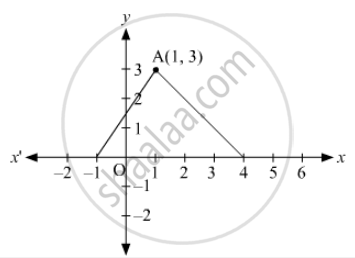Advertisements
Advertisements
प्रश्न
If the points A(1, –2), B(2, 3) C(a, 2) and D(– 4, –3) form a parallelogram, find the value of a and height of the parallelogram taking AB as base.
उत्तर
Since diagonals of a parallelogram bisect each other.
Coordinates of the midpoint of AC = coordinates of the midpoint of BD.
\[\Rightarrow \left( \frac{a + 1}{2}, \frac{2 - 2}{2} \right) = \left( \frac{- 4 + 2}{2}, \frac{- 3 + 3}{2} \right)\]
\[ \Rightarrow \left( \frac{a + 1}{2}, 0 \right) = \left( - 1, 0 \right)\]
\[\text{ On comparing, } \]
\[ \Rightarrow \frac{a + 1}{2} = - 1\]
\[ \Rightarrow a = - 3\]
\[\text{ Area of the ∆ ABC is } \]
\[A = \frac{1}{2}\left[ 1\left( 3 - 2 \right) + 2\left( 2 + 2 \right) - 3\left( - 2 - 3 \right) \right]\]
\[A = \frac{1}{2}\left[ 1 + 8 + 15 \right]\]
\[A = 12 \text{ sq . units } \]
Since, ABCD is a parallelogram,
Area of ABCD = 2 × area of triangle ABC = 2 × 12 = 24 sq. units
Height of the parallelogram is area of the parallelogram divided by its base.
Base AB is \[AB = \sqrt{\left( 1 - 2 \right)^2 + \left( - 2 - 3 \right)^2}\]
\[ = \sqrt{1^2 + 5^2}\]
\[ = \sqrt{26}\]
\[\text{ Height } = \frac{24}{\sqrt{26}} = \frac{12\sqrt{26}}{\\{13}}\]
APPEARS IN
संबंधित प्रश्न
(Street Plan): A city has two main roads which cross each other at the centre of the city. These two roads are along the North-South direction and East-West direction.
All the other streets of the city run parallel to these roads and are 200 m apart. There are 5 streets in each direction. Using 1cm = 200 m, draw a model of the city on your notebook. Represent the roads/streets by single lines.
There are many cross- streets in your model. A particular cross-street is made by two streets, one running in the North - South direction and another in the East - West direction. Each cross street is referred to in the following manner : If the 2nd street running in the North - South direction and 5th in the East - West direction meet at some crossing, then we will call this cross-street (2, 5). Using this convention, find:
- how many cross - streets can be referred to as (4, 3).
- how many cross - streets can be referred to as (3, 4).
On which axis do the following points lie?
Q(0, -2)
If (−2, 3), (4, −3) and (4, 5) are the mid-points of the sides of a triangle, find the coordinates of its centroid.
If the points A (a, -11), B (5, b), C (2, 15) and D (1, 1) are the vertices of a parallelogram ABCD, find the values of a and b.
Determine the ratio in which the point (-6, a) divides the join of A (-3, 1) and B (-8, 9). Also, find the value of a.
Show that the points A(2,1), B(5,2), C(6,4) and D(3,3) are the angular points of a parallelogram. Is this figure a rectangle?
If (2, p) is the midpoint of the line segment joining the points A(6, -5) and B(-2,11) find the value of p.
Find the ratio which the line segment joining the pints A(3, -3) and B(-2,7) is divided by x -axis Also, find the point of division.
If A(−3, 5), B(−2, −7), C(1, −8) and D(6, 3) are the vertices of a quadrilateral ABCD, find its area.
If (x, y) be on the line joining the two points (1, −3) and (−4, 2) , prove that x + y + 2= 0.
Write the condition of collinearity of points (x1, y1), (x2, y2) and (x3, y3).
If points A (5, p) B (1, 5), C (2, 1) and D (6, 2) form a square ABCD, then p =
In Fig. 14.46, the area of ΔABC (in square units) is

Write the equations of the x-axis and y-axis.
Signs of the abscissa and ordinate of a point in the second quadrant are respectively.
Abscissa of all the points on the x-axis is ______.
Points (1, – 1), (2, – 2), (4, – 5), (– 3, – 4) ______.
Points (1, –1) and (–1, 1) lie in the same quadrant.
The coordinates of a point whose ordinate is `-1/2` and abscissa is 1 are `-1/2, 1`.
